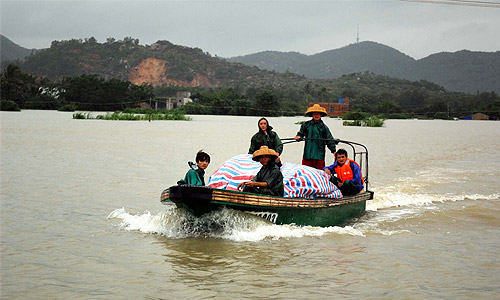|
 |
|
AID BOAT: On October 7, a boat carrying food, water and quilts distributed by the local government heads to residents stranded by floods in Wanning, Hainan Province, which has been struck by the worst flooding in decades (HOU JIANSEN) |
For ten days between September and October, China's southernmost province, Hainan, was battered by continuous rainstorms that could be the worst downpour the island has experienced since 1961. From September 30 to October 9, thousands of villages in 16 counties were flooded, testing the island province that is slated to become a future international tourist destination in the years to come as part of China's development strategy.
The heavy rains exposed the frail side of the island's tourist industry, including faulty urban management referring to the disaster forecast and warning systems, emergency systems and drainage infrastructure in cities like Sanya.
According to the China Meteorological Administration, the storm deposited a large amount of rainwater: an average of 608.1 mm of rainfall from 8 p.m. on September 30 to 8 a.m. on October 8, the highest record in corresponding period. From October 1-8, the average cumulative rainfall at 94 meteorological stations covering 8 cities and counties was higher than 800 mm. The 46 stations in Qionghai, Ding'an, Haikou and Wenchang had over 1,000 mm cumulative rainfall with 5 over 1,400 mm.
As of now, waters had flooded 16 cities and counties, and 182 towns and villages, affecting 2.5 million residents and ravaging about 138,870 hectares of crops. Landslides occurred across the province and more than 1,000 reservoirs were in danger of overflowing as storage capacities increased rapidly. The island's main east traffic corridor was waterlogged and all but cut off by the floodwaters.
The rainstorm was a true test to Hainan's still-growing tourist industry. And with the weeklong National Day holiday from October 1-7 occurring in the midst of the storm, tourist numbers continued to increase in tandem with rising floodwaters. Statistics issued by Hainan Holiday Tourism Office showed that about 150,000 tourists arrived in Hainan during the first three days of the holiday, most of whom were trapped in hotels due to the rainstorm. The number of tourists to visit 10 of the island's top tourist attractions was only about 30,000.
After the disaster, President Hu Jintao urged officials to conduct evacuations in a timely manner and get rescue efforts moving as quickly as possible. They should also prevent secondary disasters from happening to reduce losses as much as possible, the Chinese president said.
Thousands have been devoted to disaster relief and rescue efforts, and already 336,800 residents have been relocated. Moreover, part of the disaster relief materials issued by the Office of State Flood Control and Drought Relief Headquarters have been sent to the disaster zone, including 60 rubber boats, 20,000 life jackets, 400,000 knitted bags and 250 emergency lights. The civil administrations of Hainan Province and neighboring Yunnan Province and Guangxi Zhuang Autonomous Region have collected funds and donations to support residents in the disaster region. Food and drinking water has also been supplied.
Extreme weather events have been common in China this year. Since June, 10 provinces in China's southern part including Fujian, Guangdong, Hunan and Jiangxi have suffered from rainstorms and flood disasters. Now Hainan has been added to the list of affected provinces. Experts agree that natural factors are responsible for the disasters, and specifically cite the La Nina phenomenon caused by the North Pole Wave as a cause. Moreover, with global warming, a great deal of seawater will evaporate into the atmosphere leading to an increase in extreme weather events.
Furthermore, rapid urbanization, and the ballooning in skyscraper construction obstructing air passage and increase in car exhaust as more people buy cars, adds to the rain island effect that can bring about more rainfall, said Qin Dahe, a Chinese Academy of Sciences (CAS) member.
Waterlogged roads and seawater encroachment revealed problems in the island's urban planning and construction. For example, the municipal drainage system in Sanya is obviously out-of-date, with few proper drainage channels under most sections of the highways in the city.
Besides, Wang Yong, mayor of Sanya, expressed that the ineffective communication between relevant departments and lack of overall plans were also obstacles in the way of disaster relief and rescue efforts. Now, the municipal government of Sanya is making efforts to arrange reconstruction plans, including changing the urban drainage system and establishing a disaster emergency system.
Experts warned that many cities in China currently have problems with their urban drainage systems, either with aging pipelines that frequently become blocked or scanty drainage construction, because the plans pay too much attention to construction on the ground rather than underground. Moreover, with global climate change, previous standards and systems for disaster prevention are apparently not enough. As experts advised, cooperating and sharing the workload reasonably among relevant departments —both governmental and civilian—will be key to reducing losses in times of disaster and in dealing with the extreme climate changes in the future. |
